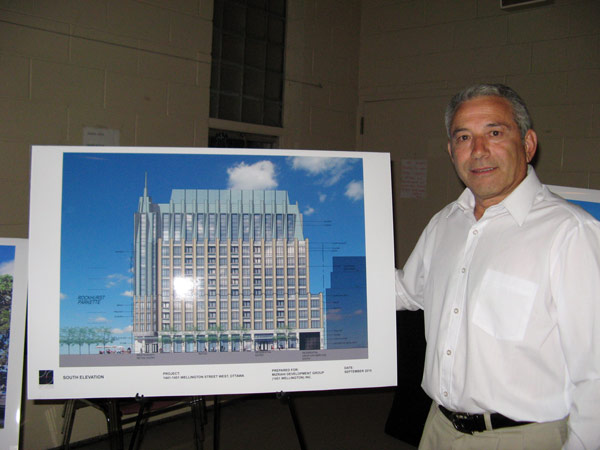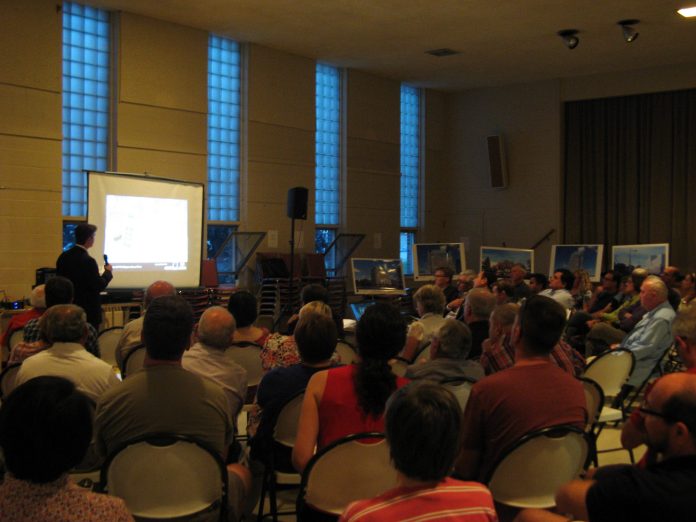By Bradley Turcotte –
Dozens of area residents filled the Kitchissippi United Church to voice their concerns about the proposed Mizrahi Developments condo building on Wellington Street West at an information session hosted by City Councillor Jeff Leiper September 24.
The focus of the meeting hinged on its “landmark status” architecture.
City Council rejected Sam Mizrahi’s proposal of a 12-storey building in 2014. The developer then appealed to the Ontario Municipal Board (OMB), an independent adjudicative tribunal that hears appeals, usually falling under the provincial Planning Act. The OMB has the ability to approve, overturn or modify City Council decisions.
The OMB’s decision states Mizrahi can go forth with a nine-storey building or demonstrate “landmark” architecture on a 12-storey building.
Several residents in attendance were confused by the term, which is defined as “urban design elements that create distinctive visual orientation points and marks … an architectural form that is highly distinctive relative to its surrounding community.”
The definition was met with audible groans from the audience, with some later stating it looked as though a decorative cap is being added to a condominium.
Architect Henry Burstyn says the design is improving with every revision, and his team has taken cues from existing Ottawa landmark buildings.
“The top has come to the forefront and… everything that we’ve done in the design now is to precipitate the ornate top of the building,” says Burstyn.
When asked if attendees liked the architecture, a crescendo of applause erupted throughout the audience.
“I think that spoke volumes about what people thought about the architecture and achieving landmark status,” says Mizrahi. “The vast majority of the room was in favour of it.”
Concerns from residents include the precedent a 12-storey building would set for the neighbourhood, and the oxidization of the copper roof. Mizrahi confirmed the roof would oxidize naturally.
One attendant questioned the cost of the environmental cleanup process and accused Mizrahi of planting supporters in the audience. Mizrahi called the accusation “ridiculous.”
There are supporters of this development, Leiper offers, and it is common for developers to encourage their supporters to be vocal at information sessions.
The City Planning Committee will look over the new proposal on October 27 and vote on how to direct City lawyers in the OMB process.
Leiper expects the issue to go to City Council the following day where they will decide whether the development’s landmark architecture merits the 12 storeys. Mizrahi and the City go back to the OMB board November 7.
Leiper commends Mizrahi’s engagement with the community and the project’s “beautiful architecture” but Leiper does not support the development at 12 storeys.
“I don’t think the architecture is landmark enough to go above the secondary plan height [of nine storeys],” he says.
The secondary design arose out of the community design plan, which sets guidelines for how the neighborhood will intensify.
“The plan calls for nine at that location and there’s no universally-agreed-to benefit to the community that would justify going above nine.”
Leiper says he will persuade his colleagues at City Hall to “stick to the plan” before meeting with the OMB.
“There are people who consider this a beautiful building,” says Leiper. “You heard from people who say ‘nothing has happened on that site, it will never get developed at nine storeys. Let’s agree to the 12,’ that’s a legitimate point of view. My sense is that the large majority opinion is against Mizrahi going above the nine storeys.”


